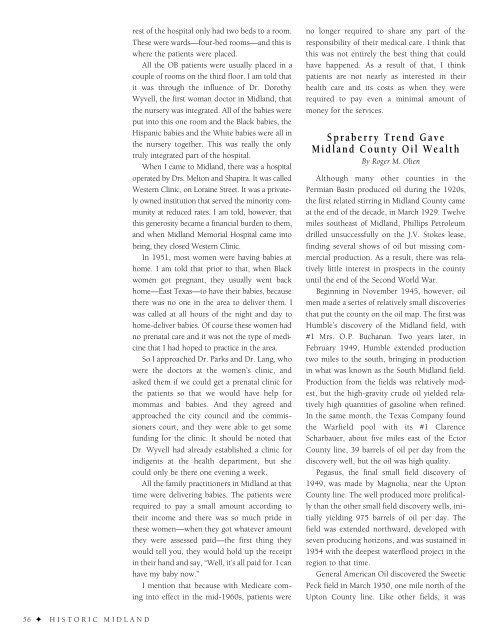Historic Midland
An illustrated history of the Midland County area, paired with the histories of companies, families and organizations that make the region great.
An illustrated history of the Midland County area, paired with the histories of companies, families and organizations that make the region great.
Create successful ePaper yourself
Turn your PDF publications into a flip-book with our unique Google optimized e-Paper software.
est of the hospital only had two beds to a room.<br />
These were wards—four-bed rooms—and this is<br />
where the patients were placed.<br />
All the OB patients were usually placed in a<br />
couple of rooms on the third floor. I am told that<br />
it was through the influence of Dr. Dorothy<br />
Wyvell, the first woman doctor in <strong>Midland</strong>, that<br />
the nursery was integrated. All of the babies were<br />
put into this one room and the Black babies, the<br />
Hispanic babies and the White babies were all in<br />
the nursery together. This was really the only<br />
truly integrated part of the hospital.<br />
When I came to <strong>Midland</strong>, there was a hospital<br />
operated by Drs. Melton and Shapira. It was called<br />
Western Clinic, on Loraine Street. It was a privately<br />
owned institution that served the minority community<br />
at reduced rates. I am told, however, that<br />
this generosity became a financial burden to them,<br />
and when <strong>Midland</strong> Memorial Hospital came into<br />
being, they closed Western Clinic.<br />
In 1951, most women were having babies at<br />
home. I am told that prior to that, when Black<br />
women got pregnant, they usually went back<br />
home—East Texas—to have their babies, because<br />
there was no one in the area to deliver them. I<br />
was called at all hours of the night and day to<br />
home-deliver babies. Of course these women had<br />
no prenatal care and it was not the type of medicine<br />
that I had hoped to practice in the area.<br />
So I approached Dr. Parks and Dr. Lang, who<br />
were the doctors at the women’s clinic, and<br />
asked them if we could get a prenatal clinic for<br />
the patients so that we would have help for<br />
mommas and babies. And they agreed and<br />
approached the city council and the commissioners<br />
court, and they were able to get some<br />
funding for the clinic. It should be noted that<br />
Dr. Wyvell had already established a clinic for<br />
indigents at the health department, but she<br />
could only be there one evening a week.<br />
All the family practitioners in <strong>Midland</strong> at that<br />
time were delivering babies. The patients were<br />
required to pay a small amount according to<br />
their income and there was so much pride in<br />
these women—when they got whatever amount<br />
they were assessed paid—the first thing they<br />
would tell you, they would hold up the receipt<br />
in their hand and say, “Well, it’s all paid for. I can<br />
have my baby now.”<br />
I mention that because with Medicare coming<br />
into effect in the mid-1960s, patients were<br />
no longer required to share any part of the<br />
responsibility of their medical care. I think that<br />
this was not entirely the best thing that could<br />
have happened. As a result of that, I think<br />
patients are not nearly as interested in their<br />
health care and its costs as when they were<br />
required to pay even a minimal amount of<br />
money for the services.<br />
Spraberry Trend Gave<br />
<strong>Midland</strong> County Oil Wealth<br />
By Roger M. Olien<br />
Although many other counties in the<br />
Permian Basin produced oil during the 1920s,<br />
the first related stirring in <strong>Midland</strong> County came<br />
at the end of the decade, in March 1929. Twelve<br />
miles southeast of <strong>Midland</strong>, Phillips Petroleum<br />
drilled unsuccessfully on the J.V. Stokes lease,<br />
finding several shows of oil but missing commercial<br />
production. As a result, there was relatively<br />
little interest in prospects in the county<br />
until the end of the Second World War.<br />
Beginning in November 1945, however, oil<br />
men made a series of relatively small discoveries<br />
that put the county on the oil map. The first was<br />
Humble’s discovery of the <strong>Midland</strong> field, with<br />
#1 Mrs. O.P. Buchanan. Two years later, in<br />
February 1949, Humble extended production<br />
two miles to the south, bringing in production<br />
in what was known as the South <strong>Midland</strong> field.<br />
Production from the fields was relatively modest,<br />
but the high-gravity crude oil yielded relatively<br />
high quantities of gasoline when refined.<br />
In the same month, the Texas Company found<br />
the Warfield pool with its #1 Clarence<br />
Scharbauer, about five miles east of the Ector<br />
County line, 39 barrels of oil per day from the<br />
discovery well, but the oil was high quality.<br />
Pegasus, the final small field discovery of<br />
1949, was made by Magnolia, near the Upton<br />
County line. The well produced more prolifically<br />
than the other small field discovery wells, initially<br />
yielding 975 barrels of oil per day. The<br />
field was extended northward, developed with<br />
seven producing horizons, and was sustained in<br />
1954 with the deepest waterflood project in the<br />
region to that time.<br />
General American Oil discovered the Sweetie<br />
Peck field in March 1950, one mile north of the<br />
Upton County line. Like other fields, it was<br />
56 ✦ HISTORIC MIDLAND
















